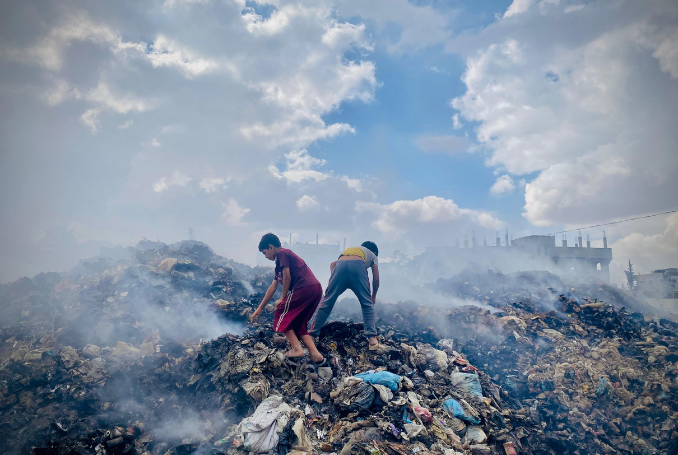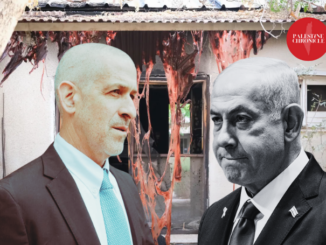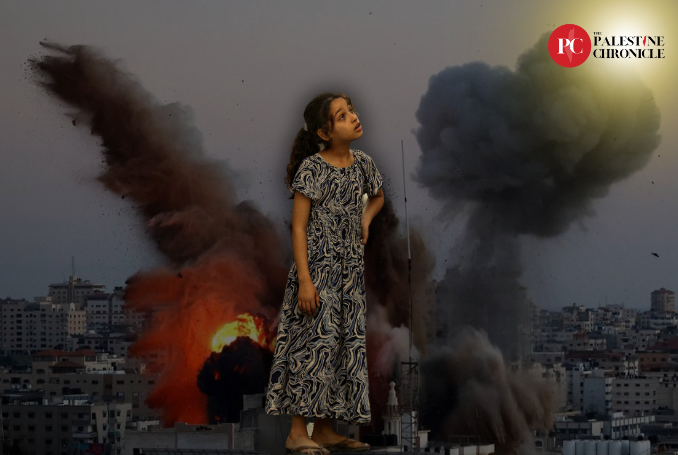
“Water and sanitation have collapsed. Critical infrastructure continues to be decimated. Coastal areas, soil and ecosystems have been severely impacted.”
The environmental impacts of Israel’s war on Gaza are unprecedented, with an estimated 39 million tonnes of debris having been generated by the conflict, according to a preliminary assessment published by the UN Environment Programme (UNEP).
“Not only are the people of Gaza dealing with untold suffering from the ongoing war, the significant and growing environmental damage in Gaza risks locking its people into a painful, long recovery,” Inger Andersen, UNEP Executive Director, said in a statement on Tuesday.
“While many questions remain regarding the exact type and quantity of contaminants affecting the environment in Gaza, people are already living with the consequences of conflict-related damage to environmental management systems and pollution today,” Anderson stated.
He said “Water and sanitation have collapsed. Critical infrastructure continues to be decimated. Coastal areas, soil and ecosystems have been severely impacted. All of this is deeply harming people’s health, food security and Gaza’s resilience.”
Recurring Conflicts
For decades, Gaza’s environment has been facing degradation and pressure on its ecosystems, the consequence of recurring conflicts, rapid urbanization, high population density, political conditions, and the region’s vulnerability to climate change, the statement said.
The preliminary assessment found that the war “undoes recent, albeit limited progress on Gaza’s environmental management systems.” This included the development of water desalination and wastewater treatment facilities, a rapid growth in solar power, and investments in the restoration of the Wadi Gaza coastal wetland.
It also found that an estimated 39 million tonnes of debris have been generated by the conflict – for each square metre in the Gaza Strip, there is now over 107 kg of debris.
“This is more than five times the quantity of debris generated from the 2017 conflict in Mosul, Iraq,” the statement said.
Debris poses risks to human health and the environment, from dust and contamination with unexploded ordnance, asbestos, industrial and medical waste, and other hazardous substances, it added.
Human Remains
“Human remains buried beneath the debris must be dealt with sensitively and appropriately,” which will be “a massive and complex task.”
Gaza’s water, sanitation, and hygiene systems are almost entirely defunct, the assessment found.
It said Gaza’s five wastewater treatment plants have shut down, with sewage contaminating beaches, coastal waters, soil, and freshwater with a host of pathogens, nutrients, microplastics, and hazardous chemicals.
This poses immediate and long-term threats to the health of Gazans, marine life, and arable lands.
The enclave’s solid waste management system was also severely damaged. Five out of six solid waste management facilities in Gaza are damaged.
A shortage of cooking gas has forced families to burn wood, plastic and waste instead, endangering women and children in particular. This, coupled with fires and burning fuels, is “likely to have sharply lowered Gaza’s air quality, though no open-source air quality data is available for Gaza.”
Explosive Chemicals
Munitions containing heavy metals and explosive chemicals have been deployed in Gaza’s densely populated areas, contaminating soil and water sources, the report said.
This posed a risk to human health which will persist long after the cessation of hostilities, with unexploded ordnance especially posing serious risks to children.
Destruction of solar panels is expected to leak lead and other heavy metals, causing a new kind of risk to Gaza’s soil and water.
“Hamas’ tunnels system and Israel’s efforts to destroy them may further contribute to environmental damage,” the assessment found.
Depending on the construction standards of the tunnels and the extent to which water is being pumped into them, the preliminary assessment “warns of long-term risks to human health from groundwater contamination and to buildings constructed on potentially unstable land surfaces,” the statement said.
The report’s authors found that “resolving immediate and chronic environmental challenges in Gaza is key for its people’s health and must be integrated into recovery and reconstruction plans.”
‘Destruction Indescribable’ – Majority of Buildings in Gaza Destroyed by Israel
As soon as security conditions allow and access is granted, UNEP said it expected to undertake a field-based assessment of the extent and type of environmental degradation.
It emphasized that remediation options will be developed in consultation with Gaza’s scientific research community, public and private sector professionals, and civil society, including women and youth.
Staggering Death Toll
Currently on trial before the International Court of Justice for genocide against Palestinians, Israel has been waging a devastating war on Gaza since October 7.
According to Gaza’s Ministry of Health, 37,396 Palestinians have been killed, and 85,523 wounded. Moreover, at least 11,000 people are unaccounted for, presumed dead under the rubble of their homes throughout the Strip.
Palestinian and international organizations say that the majority of those killed and wounded are women and children.
The Israeli war has resulted in an acute famine, mostly in northern Gaza, resulting in the death of many Palestinians, mostly children.
The Israeli aggression has also resulted in the forceful displacement of nearly two million people from all over the Gaza Strip, with the vast majority of the displaced forced into the densely crowded southern city of Rafah near the border with Egypt – in what has become Palestine’s largest mass exodus since the 1948 Nakba.
Israel says that 1,200 soldiers and civilians were killed during the Al-Aqsa Flood Operation on October 7. Israeli media published reports suggesting that many Israelis were killed on that day by ‘friendly fire’.
(The Palestine Chronicle)








